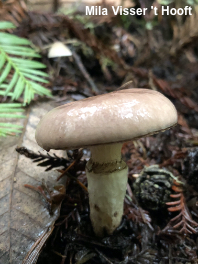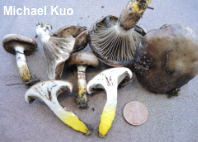Key to 10 Gomphidius Species in North America 
| 1. | With a slime veil covering the young gills, leaving thick slime on the stem as the cap expands. | 2 |
| 1. | Without a slime veil; stem not slimy. | 6 |
| 2. | Mature stem not bright yellow at the base. | |
| 2. | Mature stem bright yellow at the base or nearly overall. | 3 |
| 3. | Typically growing in clusters, often with stem bases fused; stem base often rooting; spores 10–14 µm long; known only from western North America. | |
| 3. | Not usually growing in clusters with stem bases fused; stem base not usually rooting; spores longer than 14 µm; variously distributed. | 4 |
| 4. | Cap pinkish to dull reddish; stem 0.5–1.5 cm wide. | |
| 4. | Cap more or less brown or dark purplish gray, blackening with age; stem 1–2 cm wide or more. | 5 |
| 5. | Cap 3–10 cm across; northern and montane in distribution. | |
| 5. | Cap up to 20 cm across; growing at high elevations. | Gomphidius largus |
| 6. | Young cap whitish to yellowish; stem blackening on handling; associated with eastern white pine in eastern North America. | Gomphidius nigricans |
| 6. | Young cap more highly colored; stem not blackening; mycorrhizal associations and distributions varying. | 7 |
| 7. | Spores shorter than 14 µm; known from Idaho. | Gomphidius pseudomaculatus |
| 7. | Spores longer than 14 µm; distribution varying. | 8 |
| 8. | Spores shorter than 23 µm; lower stem covered with smoky yellow to purplish black fibers. | Gomphidius maculatus |
| 8. | Many spores longer than 23 µm; lower stem not as above. | 9 |
| 9. | Spores 18–29 µm long; found in northern conifer bogs and with red spruce in the Appalachians. | Gomphidius flavipes |
| 9. | Spores 18–40 µm long; known from spruce-pine woods in Fresno County, California. | Gomphidius pseudoflavipes |
References
Kauffman, C. H. (1925). The genus Gomphidius in the United States. Mycologia 17: 113–126.
Miller, O. K. Jr. (1971). The genus Gomphidius with a revised description of the Gomphidiaceae and a key to the genera. Mycologia 63: 1129–1163.
Miller, O. K. Jr. et al. (2002). Two new species of Gomphidius from the western United States and eastern Siberia. Mycologia 94: 1044–1050.
Miller, O. K. Jr. (2003). The Gomphidiaceae revisited: a worldwide perspective. Mycologia 95: 176–183.
Singer, R. (1949). The genus Gomphidius Fries in North America. Mycologia 41: 462–489.
Thiers, H. D. (1985). The Agaricales of California. 3. Gomphidiaceae. Eureka, CA: Mad River Press. 20 pp.
This website contains no information about the edibility or toxicity of mushrooms.
Cite this page as:
Kuo, M. (2014, February). The genus Gomphidius. Retrieved from the MushroomExpert.Com Web site: http://www.mushroomexpert.com/gomphidius.html
© MushroomExpert.Com


